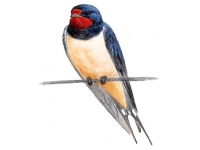News
About one million of swallows are leaving Spain for not returning
According SEO / BirdLife
"They will return the dark swallows / on your balcony to hang their nests. / But those who learned our names, / those not return". So sang in the nineteenth century the Spanish Romantic poet Gustavo Adolfo Becquer swallows each spring populate the cities of Europe. This birds, however, are becoming less common in the Old Continent. According to the environmental organization SEO / BirdLife, each year about one million swallows leave Spain for not returning, an extensive situation in Europe and due to various factors.
According to the ornithologist of the environmental organization Juan Carlos del Moral, responsible for this exodus of swallows are pesticides, the new building form -which does not allow the construction of nidos- and depopulation of rural areas. SEO / BirdLife estimated that between 1998 and 2013 the population of swallows in Spain has been reduced by 32%. In 2004 there were about 30 million swallows and since then, emphasizes the environmental organization, have lost 10 million birds.
The decline of swallows in Spain corresponds to what happens to other agricultural species. Follow-up data of 125 common species since 1998 show a general decline of the species linked to agricultural environments and increased generalists in forest media. According to IUCN criteria, the swallow could be seen in Spain within the category 'vulnerable' threat similar to that of the black stork and the black vulture category. In Europe its population experienced an even greater decline than in Spain. Data from the European Bird Census Council (EBCC) indicate a decline in Europe of 35% for the period 1990-2011.
Liability for this article lies with the author, who also holds the copyright. Editorial content from USPA may be quoted on other websites as long as the quote comprises no more than 5% of the entire text, is marked as such and the source is named (via hyperlink).






